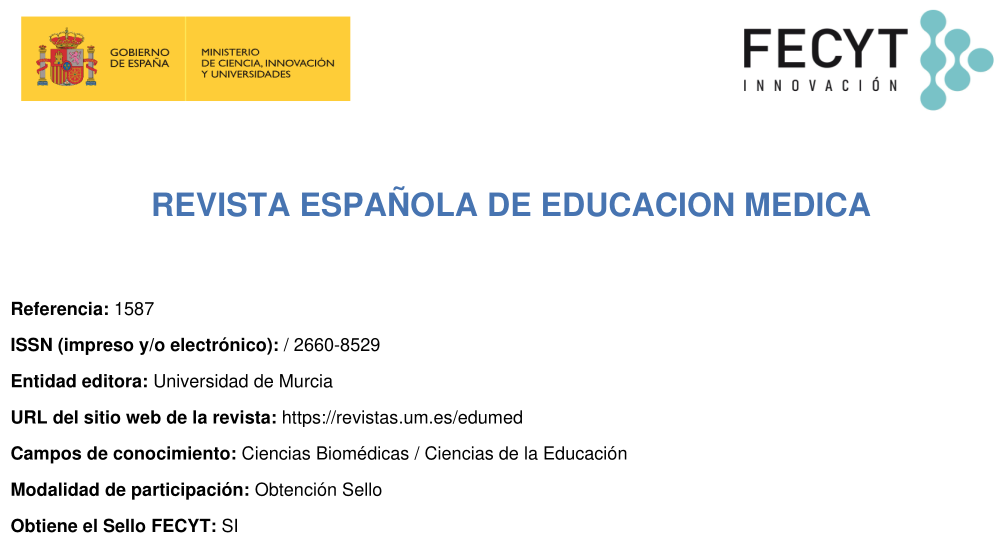Features of a Virtual Reality scenario for anatomy learning: A bibliographic review
Abstract
In recent years, virtual reality (VR) has received a great deal of attention due to its ability to sensory envelope and engage the user. This can be defined as 'The illusion of participating in a synthetic environment, rather than observing externally. VR is based on stereoscopic three-dimensional displays with head tracking, hand/body tracking, and binaural sound. VR is an immersive and multisensory experience'. It is postulated that VR could transform abstract and intangible learning into concrete and manipulable. This would be done through scaled and modifiable scenarios, especially involving anatomical structures that are difficult to learn and access when using cadaveric material. In addition, evidence shows that students are more motivated and have better perceptions when using VR in an educational context. Thus, implementing new proposals such as VR can become an efficient method in the teaching and learning process. The objective of this review is to identify how this virtual scenario should look to have a positive impact on anatomy learning. A search was carried out in three databases (ERIC, ISI: Web of Science and SCOPUS) for articles or reviews published in English or Spanish in any year. The research terms included the “impact on learning”, “virtual reality” and “anatomy”. Qualitative and quantitative, empirical or primary studies focused on the learning and/or impact of the use of VR in anatomy in higher education were included. Non-empirical or secondary studies, focused on another population, and those seeking the validation and/or construction of instruments were excluded. The findings were synthesized in two groups, virtual stage design and implementation, identifying eight principles: having an anatomically correct setting, allowing the differentiation of anatomical structures, freedom to manipulate the setting, adding theoretical support, justified choice of the virtual setting, the availability of the technological resources, priming to use VR, among others.
Downloads
Metrics
-
Abstract1462
-
pdf (Español (España))876
-
pdf876
References
Guna J, Geršak G, Humar I, Krebl M, Orel M, Lu H, et al. Virtual Reality Sickness and Challenges Behind Different Technology and Content Settings. Mob Networks Appl, 2019, 25(4), 1436–45. DOI:10.1007/s11036-019-01373-w
Schroeder R. Virtual reality in the real world: History, applications and projections. Futures, 1993, 25(9), 963–73. DOI:10.1016/0016-3287(93)90062-X
Peñasco-Martín B, Reyes-Guzmán ADL, Gil-Agudo Á, Bernal-Sahún A, Pérez-Aguilar B, Peña-González AI De. Aplicación de la realidad virtual en los aspectos motores de la neurorrehabilitación. Rev Neurol. 2010, 51(8), 481–8. DOI:10.33588/rn.5108.2009665
Ferrer-Garcia M, Pla-Sanjuanelo J, Dakanalis A, Vilalta-Abella F, Riva G, Fernandez-Aranda F et al. A Randomized Trial of Virtual Reality-Based Cue Exposure Second-Level Therapy and Cognitive Behavior Second-Level Therapy for Bulimia Nervosa and Binge-Eating Disorder: Outcome at Six-Month Followup. Cyberpsychol Behav Soc Netw. 2019, 22(1), 60-68. DOI:10.1089/cyber.2017.0675
Lioce L, Lopreiato J, Downing D, Chang T, Robertson J, Anderson M, Diaz D, et al. (Eds.) Healthcare Simulation Dictionary, 2ª ed.; Agency for Healthcare Research and Quality: Rockville, Maryland; 2020,, p. 55.
Manetta C, Blade RA. Glossary of Virtual Reality Terminology. Int J Virtual Real. 1995, 1(2), p. 35–9. DOI:10.20870/IJVR.1995.1.2.2604.
INACSL Standards Committee. INACSL Standards of Best Practice: Simulation Glossary. Clin Simul Nurs [Internet]. 2016, 12(S), p. S39–47. DOI:10.1016/j.ecns.2016.09.012 (visitado en 17 de abril de 2020)
Merriam-Webster. Virtual reality [Internet]. 2018 Disponible en: https://www.merriam-webster.com/dictionary/virtual reality (visitado en 17 de abril de 2020).
Mantovani F, Castelnuovo G, Gaggioli A, Riva G. Virtual Reality Training for Health-Care Professionals. CyberPsychology Behav. 2003, 6(4), p. 389–95. DOI: 10.1089/109493103322278772.
Gigante MA. 1- Virtual Reality: Definitions, History and Applications. En: Virtual Reality Systems. Earnshaw RA, Gigante MA, Jones H, Eds.; Academic Press: Massachusetts, Estados Unidos, 1993, p. 3–14. DOI:/10.1016/B978-0-12-227748-1.50009-3
Mompeó-Corredera B. Metodologías y materiales para el aprendizaje de la anatomía humana. Percepciones de los estudiantes de medicina ‘nativos digitales’. FEM: Rev la Fund Educ Médica, 2014, 17(2), p. 99–104. DOI:10.4321/S2014-98322014000200007.
Araujo C. J. Del cadáver a la realidad virtual en el aprendizaje de la anatomía humana en la Escuela de Medicina de la Universidad del Zulia. Rev Argentina Anatomía Online, 2017, 8(3), p. 98–101.
Rodríguez García AN. El Aprendizaje a través de la Realidad Virtual. [Tesis de Máster]. Universidad Católica de Murcia, 2019.
López Martín VM. La Realidad Virtual como Recurso Educativo en las Ciencias Experimentales. [Tesis de grado]. Universidad de Valladolid, 2018.
Toala-Palma JK, Arteaga-Mera JL, Quintana-Loor JM, Santana-Vergara MI. La Realidad Virtual como herramienta de innovación educativa. EPISTEME Koin, 2020, 3(5). DOI:10.35381/e.k.v3i5.835
Silén C, Wirell S, Kvist J, Nylander E, Smedby O. Advanced 3D visualization in student-centred medical education. Med Teach, 2008, 30(5), p. e115-24. DOI:10.1080/01421590801932228
Kockro RA, Amaxopoulou C, Killeen T, Wagner W, Reisch R, Schwandt E, et al. Stereoscopic neuroanatomy lectures using a three-dimensional virtual reality environment. Ann Anat, 2015, 201, p. 91–8. DOI:10.1016/j.aanat.2015.05.006
Nicholson DT, Chalk C, Funnell WRJ, Daniel SJ. Can virtual reality improve anatomy education? A randomised controlled study of a computer-generated three-dimensional anatomical ear model. Med Educ, 2006, 40(11), p. 1081–7. DOI:10.1111/j.1365-2929.2006.02611.x
Maresky HS, Oikonomou A, Ali I, Ditkofsky N, Pakkal M, Ballyk B. Virtual reality and cardiac anatomy: Exploring immersive three-dimensional cardiac imaging, a pilot study in undergraduate medical anatomy education. Clin Anat, 2019, 32(2), p. 238–43. DOI:10.1002/ca.23292
Chen S, Zhu J, Cheng C, Pan Z, Liu L, Du J, et al. Can virtual reality improve traditional anatomy education programmes ? A mixed- methods study on the use of a 3D skull model. BMC Med Educ, 2020, 20(1):395. DOI:10.1186/s12909-020-02255-6.
Ellington DR, Shum PC, Dennis EA, Willis HL, Szychowski JM, Richter HE. Female Pelvic Floor Immersive Simulation: A Randomized Trial to Test the Effectiveness of a Virtual Reality Anatomic Model on Resident Knowledge of Female Pelvic Anatomy. J Minim Invasive Gynecol, 2019, 26(5), p. 897–901. DOI:10.1016/j.jmig.2018.09.003
Stepan K, Zeiger J, Hanchuk S, Del Signore A, Shrivastava R, Govindaraj S, et al. Immersive virtual reality as a teaching tool for neuroanatomy. Int Forum Allergy Rhinol, 2017, 7(10), p. 1006–13. DOI:10.1002/alr.21986
Moro C, Štromberga Z, Raikos A, Stirling A. The Effectiveness of Virtual and Augmented Reality in Health Sciences and Medical Anatomy. Anat Sci Educ, 2017, 10(6), p. 549–59. DOI:10.1002/ase.1696
Escartín, E.R. La realidad virtual, una tecnología educativa a nuestro alcance. Pixel-Bit. Revista de Medios y Educación, 2000, 15, p. 5–21.
Riva G, Wiederhold BK. The New Dawn of Virtual Reality in HealthCare: Medical Simulation and Experiential Interface. Annu Rev CyberTherapy Telemed, 2015, 13, p. 3–6. DOI:10.3233/978-1-61499-595-1-3
Cantón Enríquez D, Arellano Pimente J, Hernández López M, Nieva García O. Didactic use of immersive virtual reality with NUI focused on the inspection of wind turbines. Apertura, 2017, 9(2), p. 8–23. DOI:10.32870/ap.v9n2.1049.
Alemán Marichal B, Navarro de Armas Olga L, Suárez Díaz R M, Izquierdo Barceló Y, Encinas Alemán T C. La motivación en el contexto del proceso enseñanza-aprendizaje en carreras de las Ciencias Médicas. Rev.Med.Electrón, 2018, 40(4), p. 1257–1270.
Copyright (c) 2022 Servicio de Publicaciones de la Universidad de Murcia

This work is licensed under a Creative Commons Attribution-NonCommercial-NoDerivatives 4.0 International License.
The works published in this magazine are subject to the following terms:
1. The Publications Service of the University of Murcia (the publisher) preserves the economic rights (copyright) of the published works and favors and allows them to be reused under the use license indicated in point 2.
2. The works are published under a Creative Commons Attribution-NonCommercial-NoDerivative 4.0 license.
3. Self-archiving conditions. Authors are allowed and encouraged to disseminate electronically the pre-print versions (version before being evaluated and sent to the journal) and / or post-print (version evaluated and accepted for publication) of their works before publication , since it favors its circulation and earlier diffusion and with it a possible increase in its citation and reach among the academic community.


















